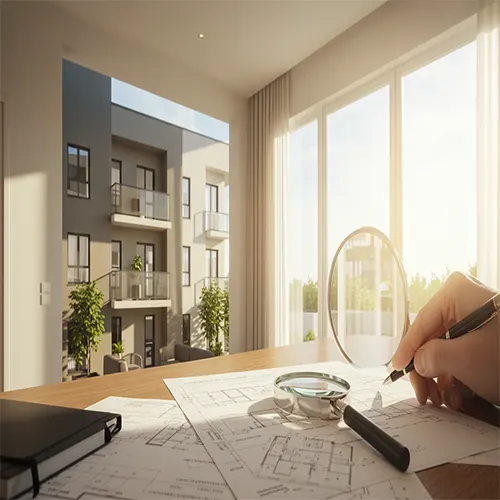املاک

صفر تا صد قانون زمین شهری
کتاب الکترونیکی: صفر تا صد قانون زمین شهری صفر تا صد قانون زمین شهری راهنمای جامع برای درک مفاهیم و

آشنایی با مفهوم و اهمیت تغییر کاربری املاک
راهنمای جامع تغییر کاربری ملک راهنمای جامع تغییر کاربری ملک مقدمه: ورود به دنیای تغییر کاربری املاک سلام! فرض کنید

همه چیز درباره صلح نامه ملکی: از صلح عمری تا ثبت رسمی + داشبورد یادگیری
راهنمای جامع صلح نامه ملکی صلح نامه ملکی: راهنمای جامع برای درک و استفاده مقدمهای بر صلح نامه ملکی سلام!

ملک عیب دار: راهنمای خرید، فروش و نکات کلیدی
“`html
The Iranian real estate market, like any other, presents opportunities and potential pitfalls. One area that demands careful attention is the world of “ملک عیب دار,” or defective properties. Whether you’re a prospective buyer or a seller, understanding the intricacies of these properties is crucial for protecting your investment and navigating the market with confidence.
What Exactly is a “ملک عیب دار”?
A “ملک عیب دار” is a property with some sort of flaw or defect. These defects can range from minor cosmetic issues to more significant structural problems, impacting a property’s value and its appeal in the market. Based on our research (and the information we’ve gathered from the current RSS feed), defects can broadly be categorized into:
- Location Issues: Problems related to the property’s surroundings (e.g., proximity to pollution, noise, or undesirable areas).
- Amenity Deficiencies: Lacking promised amenities (e.g., lack of proper parking, insufficient water pressure, broken elevators).
- Construction Quality Issues: Structural faults, poor workmanship, and issues with building materials.
Why Should You Care About Defective Properties?
Ignoring potential defects can lead to significant financial losses and frustrating disputes. This article aims to shed light on the key considerations for both buyers and sellers in the Iranian context.
For Buyers: Your Checklist for Success
Buying a property is a major investment. Here’s what you need to do to minimize the risk:
- Due Diligence is Key: Before making an offer, thoroughly inspect the property. Pay attention to details and don’t hesitate to hire a professional inspector (e.g., a qualified construction engineer).
- Ask the Right Questions: Question the seller about any known defects, even if they seem minor. Document everything in writing.
- Understand the Legal Framework: Familiarize yourself with the legal rights and regulations related to property defects in Iran. (Consult with a lawyer specializing in property law!)
- Negotiate Wisely: Use any identified defects to negotiate the price or request repairs.
- Assess the Risk: Carefully weigh the potential costs of repairing any defects against the price of the property. Don’t be afraid to walk away if the risks outweigh the benefits.
For Sellers: Transparency and Fairness
Sellers have obligations too. Here’s what you need to do to handle your sale successfully:
- Full Disclosure is a Must: Be upfront about any known defects. Honesty builds trust and protects you from potential legal issues later on.
- Price Accordingly: Adjust the asking price to reflect the property’s condition. Obtain professional appraisals for a realistic valuation.
- Prepare for Negotiations: Buyers will likely negotiate based on the defects. Be prepared to compromise or make repairs (if reasonable).
- Choose the Right Marketing Approach: Highlight the property’s positive attributes, but never hide the flaws.
- Seek Professional Advice: Consult with a real estate professional or lawyer to navigate the selling process effectively.
Valuation Considerations: Pricing a Defective Property
Calculating the value of a “ملک عیب دار” can be more complex. As explained in the research (and international best practices), valuation methodologies involve:
- Identifying the Defects: This is the first step, as the impact of the defects on the property’s value is determined by their types and scope.
- Estimate the Cost to Cure (Cost-to-Cure Approach): Determine the estimated cost to repair or rectify the defects.
- Accounting for Market Value Adjustments: Analyze comparable properties and determine how defects affect the overall property value.
- Using Information Economics: Make sure that there is no asymmetric information that could harm the buyers.
Real-World Scenarios (Case Studies)
Understanding is key to being successful in dealing with defective properties. We will consider some case studies and highlight the negotiation process and outcomes.
The Role of Professionals: Brokers, Appraisers, and Lawyers
Real estate professionals play a critical role in these transactions. They must:
- Brokers: Provide accurate information and represent their clients’ interests.
- Appraisers: Accurately assess property values, considering defects.
- Lawyers: Advise clients on legal rights and obligations.
Conclusion
Navigating the world of “ملک عیب دار” requires careful planning, due diligence, and a clear understanding of your rights and responsibilities. By following the tips outlined in this guide, both buyers and sellers in the Iranian real estate market can make informed decisions, mitigate potential risks, and ensure a fair and transparent transaction. Remember to stay informed and consult with professionals to protect your interests.
“`

تخریب املاک روستایی : دلایل، راهکارهای قانونی و نحوه اعتراض
در ایران، موضوع استفاده از اراضی روستایی و حقوق مالکیت در چارچوب “طرح هادی روستایی” بسیار مهم است، اما اغلب

بستن جلوی چک در معاملات ملکی: راهنما و نکات حقوقی
## Excerpt: بستن جلوی چک در معاملات ملکی: راهنمای جامع برای خریداران و فروشندگان
**مقدمه:**
در معاملات ملکی در ایران، چکها ابزار حیاتی پرداخت هستند، اما شرایطی پیش میآید که خریداران یا فروشندگان تمایل به “بستن جلوی چک” (متوقف کردن چک) دارند. این یک اقدام حقوقی پیچیده است که با توجه به قوانین ایران، بهویژه “قانون صدور چک”، پیامدهای مهمی دارد. این مقاله راهنمای جامع و کاربردی برای درک این فرآیند و نکات حقوقی مرتبط با آن است. ما به شما کمک میکنیم تا با جوانب مختلف بستن جلوی چک در معاملات ملکی آشنا شوید و از حقوق خود محافظت کنید.
**اهمیت بستن جلوی چک: چرا باید بدانید؟**
تصور کنید خانهای را خریداری کردهاید و چک مربوط به پرداخت اولیه را صادر کردهاید. اما متوجه میشوید ملک دارای نقص است یا فروشنده به تعهداتش عمل نمیکند. بستن جلوی چک میتواند راهکاری برای حفظ منافع شما باشد، اما باید با آگاهی کامل از قوانین انجام شود.
**1. درک قوانین: قانون صدور چک و نقش آن**
“قانون صدور چک” در ایران، برای چکها اهمیت ویژهای قائل است. این قانون، اعتبار چک را در اولویت قرار میدهد، بنابراین بستن جلوی چک، اقدامی جدی تلقی میشود. متوقف کردن پرداخت یک چک، به معنای عدم رعایت تعهد پرداخت است. قبل از اقدام به بستن جلوی چک، باید با قوانین آشنا باشید و دلایل موجهی داشته باشید.

3 روش کاربردی برای تشخیص سن آپارتمان + نکات مهم
Absolutely! Here’s the excerpt you requested, formatted for maximum SEO impact in Persian, aiming for a general audience interested in property buying/investing:
# **چگونه سن آپارتمان را تشخیص دهیم؟ 3 روش کاربردی و مهم**
**Meta Description:** آیا به دنبال خرید آپارتمان هستید؟ یکی از مهمترین فاکتورها، سن آپارتمان است. در این مقاله، 3 روش موثر برای تشخیص سن آپارتمان به همراه نکات کلیدی از جمله بررسی مدارک، ارزیابی ظاهری و تأسیسات را بررسی میکنیم تا خریدی مطمئن داشته باشید.
یکی از مهمترین سوالاتی که خریداران و سرمایهگذاران در حوزه املاک با آن مواجه میشوند، **تشخیص سن آپارتمان** است. دانستن سن دقیق آپارتمان، کلید ارزیابی ارزش واقعی ملک، پیشبینی هزینههای احتمالی تعمیرات و در نهایت، اتخاذ یک تصمیم هوشمندانه است. در این مقاله، سه روش کاربردی و ساده برای **تشخیص سن آپارتمان** را به زبان ساده و روان بررسی میکنیم.
## روش اول: بررسی اسناد و مدارک؛ مطمئنترین راه برای تشخیص سن آپارتمان
اسناد و مدارک، دقیقترین منبع برای تعیین سن دقیق آپارتمان هستند.
* **سند مالکیت:** تاریخ صدور سند، که گاهی تاریخ اتمام ساخت را نیز نشان میدهد. این تاریخ، مبنای خوبی برای **تشخیص سن آپارتمان** است.
* **پروانه ساخت:** با مراجعه به شهرداری و درخواست پروانه، میتوانید تاریخهای مهمی مانند صدور، شروع و پایان ساخت را به دست آورید.
* **صورتجلسه تفکیکی:** این سند، تاریخ تفکیک آپارتمانها از زمین اصلی را مشخص میکند.
* **استعلام از شهرداری:** شهرداریها معمولا اطلاعات کاملی در مورد ساختمانها، از جمله تاریخ ساخت، در اختیار دارند.
**نکات کلیدی:**
* **اصالت:** از صحت و اعتبار اسناد اطمینان حاصل کنید.
* **مقایسه:** اطلاعات اسناد را با سایر منابع (اظهارات مالک، بررسیهای میدانی) مقایسه کنید.
* **بازسازی:** اگر آپارتمان بازسازی شده است، تاریخ بازسازی نیز اهمیت دارد.
## روش دوم: ارزیابی ظاهری؛ نگاهی سریع به سن آپارتمان
ارزیابی ظاهری، یک تخمین اولیه از سن آپارتمان را به شما میدهد.
* **مصالح ساختمانی:**
* **آجر:** آجرهای قدیمی معمولا بزرگتر و بافت متفاوتی دارند.
* **بتن:** بررسی رنگ و کیفیت بتن (ترکها، فرسودگی).
* **کاشی و سرامیک:** طرح و سبک کاشیها نشاندهنده دوره ساخت است.
* **درب و پنجره:** سبک و جنس درب و پنجرهها.
* **سبک معماری:** سبک معماری (کلاسیک، مدرن و …) میتواند نشاندهنده دوره ساخت باشد.
* **نشانههای فرسودگی:**
* **ترکها:** وجود ترکهای بزرگ.
* **رطوبت:** نم و رطوبت روی دیوارها.
* **لقی و فرسودگی:** در کفپوشها و دربها.
* **امکانات و تجهیزات:** وجود آسانسور، سیستم گرمایش مرکزی و…
**نکات کلیدی:**
* **بازسازی:** بازسازیها ظاهر ساختمان را تغییر میدهند.
* **مقایسه:** آپارتمان را با ساختمانهای مشابه در منطقه مقایسه کنید.
* **مشاوره:** در صورت نیاز، از کارشناسان کمک بگیرید.
## روش سوم: بررسی تأسیسات و تجهیزات؛ وضعیت و عمر مفید
این روش، اطلاعاتی درباره وضعیت و عمر مفید تأسیسات آپارتمان ارائه میدهد.
* **لولهکشی:** جنس لولهها و وضعیت آنها.
* **برقکشی:** نوع سیمکشی و وضعیت کلیدها و پریزها.
* **گرمایش و سرمایش:** نوع سیستم (پکیج، کولر گازی) و سن تجهیزات.
* **آسانسور:** سن و وضعیت آسانسور.
**نکات کلیدی:**
* **استانداردها:** تأسیسات باید با استانداردهای روز دنیا نصب شده باشند.
* **گزارشهای نگهداری:** بررسی گزارشهای نگهداری و تعمیرات.
* **عمر مفید:** در نظر گرفتن عمر مفید تجهیزات (لولهکشی، سیمکشی، سیستمهای گرمایشی و…).
## نتیجهگیری: خریدی هوشمندانه با اطلاعات دقیق
**تشخیص سن آپارتمان** یک فرآیند مهم است. با استفاده از این سه روش و در نظر گرفتن نکات مهم، میتوانید اطلاعات دقیقی در مورد **سن آپارتمان** مورد نظر خود به دست آورید و با اطمینان خاطر بیشتری برای خرید یا سرمایهگذاری اقدام کنید.
**[Call to action – Optional: “برای اطلاعات بیشتر و مشاوره تخصصی با ما تماس بگیرید!”]**

چرا ارزیابی املاک باید توسط کارشناس رسمی انجام گیرد؟؟؟؟
چرا ارزیابی ملک باید توسط کارشناس رسمی دادگستری انجام شود؟ در دنیای پرشتاب امروزی، سرمایهگذاری در املاک و مستغلات به

خرید آپارتمان نوساز بدون پایان کار: راهنمای جامع و نکات کلیدی
This is a great excerpt! It effectively covers the key aspects of buying a new apartment without a “pāyān-e kār” (completion certificate) in a clear, informative, and accessible way. Here’s a breakdown of its strengths:
* **Engaging Introduction:** The opening lines immediately draw the reader in with a relatable scenario – the allure of a new apartment.
* **Clearly Defined Problem:** It quickly and concisely identifies the core issue: the lack of a completion certificate and its implications.
* **Identifies Risks:** The excerpt clearly outlines the potential problems buyers face, like legal uncertainties, financial risks, and the possibility of construction flaws.
* **Offers Practical Solutions:** It provides actionable advice, breaking down the solutions into manageable steps, such as:
* Due diligence (investigating the property’s history, consulting with experts).
* Contractual considerations (specifying terms, including escape clauses and guarantees).
* Technical inspections (assessing the building’s quality and compliance).
* **Highlights the Best Approach:** It synthesizes the solutions by recommending a balanced approach of caution and smart decision-making.
* **Provides a Concise Summary:** The excerpt efficiently summarizes the key steps to approach the situation.
* **Encouraging Tone:** The concluding message is optimistic and empowering, reinforcing the idea that informed decision-making is key.
* **Well-Organized and Easy to Read:** The structure is logical, using headings and bullet points to make information accessible and easy to follow.
**Possible Improvements (Optional):**
* **Specificity in Legal Advice:** While it rightly mentions consulting with a lawyer, you could subtly add: “Specifically, a lawyer specializing in real estate law (amlak) can guide you…”
* **Adding the “Pāyān-e Kār” as a Search Term:** You might consider including the term “pāyān-e kār” in a parenthetical in the beginning, so it can be easily searchable by the target audience.
* **Real-World Examples:** Adding a short, hypothetical example of a common problem and how a solution could play out may also improve reader engagement.
**Overall:** This is a well-written and helpful guide for potential buyers in Iran. It provides a good balance of warning and encouragement. The tone is reassuring and practical, making it a valuable resource for anyone navigating this potentially tricky real estate situation.

چالش پیشخرید از تعاونیها: کابوس یا فرصت طلایی؟
تا حالا به فکر خانهدار شدن افتادی؟ یا شاید دنبال یه سرمایهگذاری خوب بودی؟ پیشخرید از تعاونیهای املاک میتونه یه

